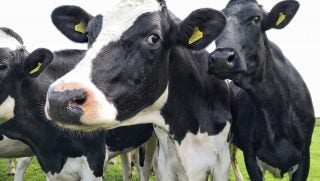Mountain lions are on the prowl, but according to a new study conducted in North Dakota and South Dakota however, livestock in the Great Plains may be relatively safe from the big cats.
“There is a risk every time livestock and predators are together,” said Kansas State University animal scientist Charlie Lee in a recent release. “That being said, it seems that the likelihood of mountain lion predation is extremely low in Kansas.”
The study examined the food habits of cougars in prairie and agricultural habitats.
Lee, who is a wildlife management specialist with K-State Research and Extension, noted that while there have been studies of mountain lion eating habits conducted in other regions, it is important to research food sources in the Plains as there are different animals in these regions.
“These cougars were collected from various locations across those two states in a wide variety of habitats that are not much different from what we would expect to see in Kansas,” Lee said. “The terrain was short grasses and mixed grass prairies with large agricultural fields.”
Of the 14 animals evaluated, half of the cougars had either mule deer or white-tailed deer in their system. Other native species found in the intestines included jackrabbits, porcupines, beavers, badgers, minks, and other rodents. Porcupine remains were found in two of the animals and 87 percent of the cougars had porcupine quills in their skin or flesh.
“There were no domestic livestock species documented as part of the cougar diet,” Lee said, but noted that the remains of domestic house cat were found in the stomachs of two of the cougars.
Lee said it is rare for cougars to attack horses. Fence materials such as barbed wire can cause injuries that could be mistaken for a cougar attack.
Lee encourages livestock producers to consider more common predators, such as coyotes, before assuming an attack was by a cougar. Careful examination of the remains to determine killing and feeding patterns, tracks, and scat will help determine the cause when losing a domestic animal.
The South Dakota Games, Fish and Parks department offer these precautions if you live in lion country:
- Do not intentionally feed wildlife.
- When outdoors make lots of noise during the times mountain lions are most active – dusk to dawn.
- Install outside lighting. Light areas where you walk so you can see a mountain lion if it is present.
-
Closely supervise children whenever they play outdoors. Make sure children are inside before dusk and not outside until after dawn.
-
Landscape or remove vegetation to eliminate hiding places for mountain lions, especially around children’s play areas.
-
Make it difficult for lions to approach unseen. Plant only shrubs that deer will not browse to discourage concentrations of deer. Predators follow prey.
-
Keep pets under control. Roaming pets are easy prey and can attract mountain lions.
-
Place livestock in enclosed sheds or barns at night. Close doors to all outbuildings since inquisitive mountain lions may go inside for a look.
-
Mountain lions cover their kill. If you find what looks like a lion kill, stay clear. The lion may be guarding it.
-
Encourage your neighbors to follow these precautions. These measures will help prevent a possible mountain lion confrontation.


